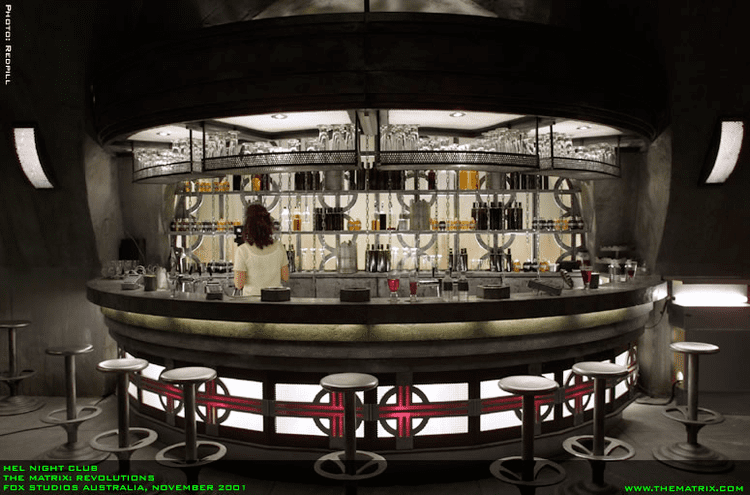 | ||
Mega City is an enormous virtual megacity in which the inhabitants of the Matrix live their lives in the Matrix series. The City is a conglomeration of many cities, fused into one large city with a gigantic downtown and an impressive skyline.
Contents
- Design and description
- Philosophy and hyperreality
- The Matrix Online
- Club Hel
- Locations outside of Mega City
- References
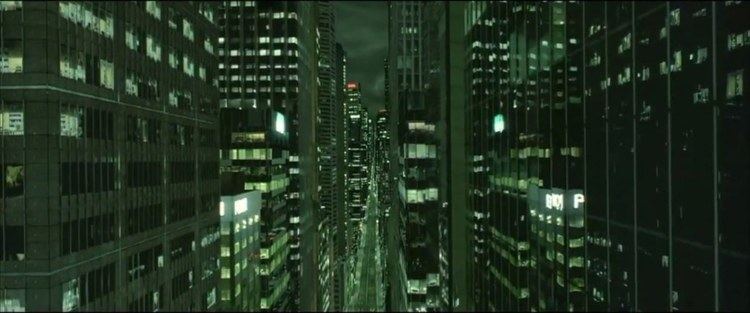
Design and description
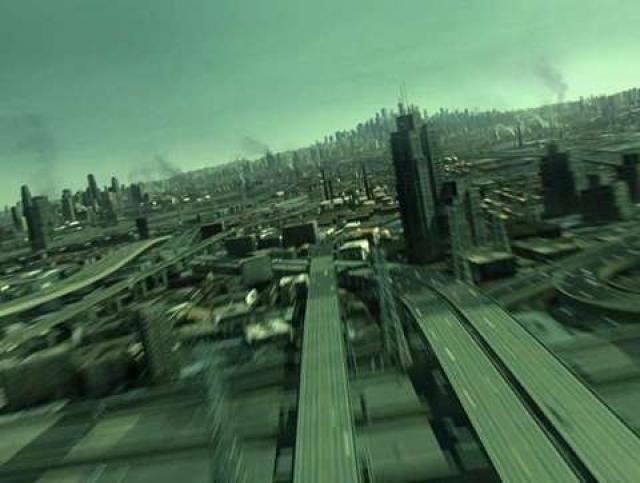
The city was designed to represent an amalgam of any number of major cities in the United States during the 1990s; i.e., gray and utilitarian with small pockets of color and entertainment.
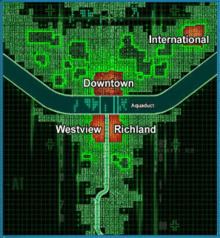
According to the films' graphic designer Suzanne Buljan, companies and utilities in the city were uniformly given generic "City" names which are seen on signage and vehicles throughout the films, such as City Metro, City Waste, City Rail, City Post and City Power:
"Everything is City-something; all the facilities are City related."
Philosophy and hyperreality
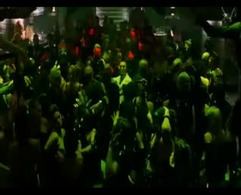
The concept of the City in The Matrix and its sequels is an archetype of the hyperreality theory proposed by Jean Baudrillard and developed by Umberto Eco; that is that the virtual "city" constructed by the machines controlling the society is more convincing and realistic to its inhabitants than the "real world" – a dystopian futur noir portrayed in stark contrast to the virtual one.
The harsh, gray, uninteresting landscape was implemented to make sure the unknowing inhabitants of the Matrix did not question their living space, lacking an alternative. It is possible that the City is an inhabitant-unique environment, in which no one sees things the same way. The visualization of the City as gray and unnatural in The Matrix could possibly be a result of the redpills' experience outside of the Matrix. Further, Agent Smith describes to a captured Morpheus that earlier instances of the Matrix which were cheerier did not meet the (subconscious) expectations of the humans hosted within; the Architect later expands on that explanation, telling Neo that the first versions failed because they were designed around two extremes (perfect paradise and absolute hell) that the human mind was unable to accept.
The Matrix Online
The Wachowskis provided a map of Mega City for the designers of the MMO game The Matrix Online, which splits the city into four main districts: Downtown, International, Richland (ironically called the "slums" by the redpills), and Westview.
The map shows that the actual shape of the city represents the Y-shaped symbol seen at the end of the code sequence in The Matrix Revolutions.
A series of "factoids" appearing on computer screens within The Matrix Online game imply that Metacortex, the company Thomas Anderson worked for in the first film, was responsible for obtaining the data required to create the city: "Metacortex is involved in several government programs to index and catalog the history of all citizens in order to provide greater security for you and your family."
Club Hel
In the Matrix series, Club Hel is a nightclub run by the Merovingian, a ruthless, powerful elder program in the Matrix. The club appears in the film The Matrix Revolutions and the games The Matrix Online and The Matrix: Path of Neo.
The club is located in the basement level of a building in the Mega City. The entrance is guarded by armed supernatural programs with gravity-defying capabilities.
In The Matrix Revolutions, Morpheus, Trinity, and Seraph defeat these guards before proceeding to the inner chamber. Here they meet with the Merovingian to barter for Neo's escape from the Mobil Avenue Station, a computer construct run by the Merovingian's henchman, the Trainman. After Trinity starts a fight and creates a Mexican standoff with the Merovingian, Neo is freed.
The name is drawn from the realm of Hel in Norse Mythology, where a goddess of the same name ruled over the spirits of those who died ingloriously or who broke oaths. Similarly, the Merovingian offers protection for Exiles (programs that have been rendered obsolete and are scheduled for deletion), and acts as an information broker, but usually requires payment of some kind in exchange for his services.
The name of the Merovingian's wife Persephone is a reference to Greek mythology, in which Hades, the god of the underworld, kidnapped and married a young maiden named Persephone, who always remained resentful of him and unhappy with her marriage. Similarly, The Matrix's Persephone is constantly working against her husband and trying to undermine his endeavors, even though there is never a mention of the possibility of their separation.
There is also some allusion to hell. The décor of this club is theological and mythological in nature. Eve of biblical fame can be seen in the background holding the forbidden fruit of knowledge, which she had eaten and fed to Adam.
The club is a depiction of a gothic/fetish nightclub, filled with stereotypical members of goth, punk, and other modern subcultures. Some of the patrons even appear to be engaging in heterosexual and homosexual acts. It is similar to the club in the first Matrix film in which Neo first meets Trinity. The patrons are Exiles in fact, and their attire and mannerisms are tied into the supernatural beings they are thought to be emulating (two Exiles standing guard to the Merovingian's balcony look like Satyrs, or possibly Minotaurs). A majority of the Exiles present are Vampires, Lupines, and other creatures from previous versions of the Matrix.
Locations outside of Mega City
The revelation that the Matrix films and games take place in a single megacity was surprising, as there were several references to other places and cultures throughout the series. This gave rise to the speculation that the Matrix contains only one city, wherein the names, media, and language differences exist to convince the inhabitants that an entire world exists outside it. References to other places are shown below.
It has never been explicitly stated that the Megacity is or is not the only location in the Matrix, though the implication throughout the franchise is that the world as a whole is simulated to some degree.
